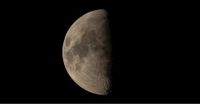For skywatchers across the Northern Hemisphere, August 2025 is shaping up to be a spectacular month for lunar and planetary events. From the subtle beauty of the moon’s shifting phases to rare astronomical phenomena, there’s no shortage of celestial wonders to keep stargazers glued to the night sky. Whether you’re peering through a telescope, scanning the heavens with binoculars, or simply gazing upward with the naked eye, this month promises something for everyone.
According to NASA, the lunar cycle is a regular rhythm lasting about 29.5 days, marked by eight distinct phases that chart the moon’s journey around Earth. Each phase reveals a different aspect of our nearest celestial neighbor, as sunlight illuminates varying portions of the lunar surface. As of Saturday, August 16, 2025, we find ourselves firmly in the Third Quarter—also known as the Last Quarter—phase. On this night, the moon is 46% lit up from our vantage point on Earth, a detail confirmed by NASA’s Daily Moon Observation. This means we’re on day 23 of the lunar cycle, and the moon’s visible face will continue to shrink as we approach the New Moon.
The Third Quarter isn’t just a technical term—it’s a visual treat. The left half of the moon is illuminated, and keen-eyed observers can spot some of the moon’s most famous features. With the unaided eye, you might catch the Aristarchus Plateau, the Tycho Crater, and the Copernicus Crater. Binoculars reveal even more: the Archimedes Crater, Alphonsus Crater, and the Clavius Crater. If you’re fortunate enough to have a telescope, look out for the Apollo 12 site, Reiner Gamma, and the Schiller Crater. These features are especially prominent as the sun’s rays cast dramatic shadows across the lunar landscape.
But the moon isn’t the only show in town this week. According to the Wausau Pilot & Review, central Wisconsin skywatchers have a packed calendar of events, from predawn planet pairings to the shadow of Saturn’s largest moon, Titan, crossing the planet’s rings. On Friday, August 15, the dwarf planet Ceres reaches its stationary point in the constellation Cetus and begins retrograde motion, visible in the morning sky. That same evening, asteroid 4 Vesta in Libra shines at magnitude 7.4, making it an easy target for binoculars. The best place to catch Vesta? The west overlook at Rib Mountain, where a clear southwest horizon offers ideal conditions.
As the weekend unfolds, the moon continues its celestial dance. On August 16, the Last Quarter Moon appears near the Pleiades star cluster in Taurus, a sight best enjoyed two hours before sunrise. Uranus, the ice giant, lies just 4.4° southeast of the Pleiades, appearing as a blue-gray dot through a telescope. For those eager to catch this pairing, the open fields west of Marathon City provide a low eastern horizon perfect for pre-dawn viewing.
That same morning, the moon sits just under 4° west of the Pleiades, as reported by Astronomy magazine. At 1:12 a.m. EDT, the Last Quarter Moon officially occurs, and as the night progresses, the moon will move closer to the cluster, even occulting several of its stars—a rare event visible from Japan, Korea, and northeast Asia. Later in the day, the moon will pass 5° due north of Uranus at 4 p.m. EDT. Uranus itself shines at magnitude 5.7, with a tiny 4” disk, nestled near the 6th-magnitude stars 13 and 14 Tauri.
The moon’s journey is marked by precise timings. On August 16, sunrise occurs at 6:13 a.m. and sunset at 7:55 p.m., with moonrise at 11:58 p.m. and moonset at 2:48 p.m. The moon’s illumination is around 44%, described as a waning crescent by Astronomy magazine. These shifting phases are more than just calendar dates—they’re a reminder of the moon’s constant motion and the intricate ballet of the solar system.
As the week continues, more cosmic spectacles await. On August 17, the Summer Triangle—formed by the bright stars Vega, Deneb, and Altair—dominates the midnight sky, framing the Milky Way’s rich starfields. The open cluster NGC 6910 near Sadr in Cygnus is a prime target for binoculars. On August 18, Saturn takes center stage as Titan’s shadow transits the planet, an event starting at 12:26 a.m. CDT. Through a telescope, observers can also spot Saturn’s moons Dione, Tethys, and Rhea.
Early risers on August 19 will be rewarded with Mercury at its greatest western elongation, shining at magnitude 0 in Cancer, just 2° south of the Beehive Cluster. Jupiter and Venus line up with Delta Geminorum, and the crescent moon appears 7° above Jupiter. By August 22, comet C/2024 E1 (Wierzcho?) glows faintly in Hercules, and the moon reaches its New phase—an astronomical milestone that also marks the arrival of a rare black moon.
So, what exactly is a black moon? According to Space.com and the Old Farmer’s Almanac, a black moon is a rare type of new moon, occurring in one of several ways. This August, it’s a seasonal black moon—the third of four new moons in a single season, a phenomenon that happens roughly once every 33 months. Black moons are invisible from Earth, making them the perfect backdrop for stargazing. The next seasonal black moon after August 23, 2025, won’t occur until August 20, 2028, while the next monthly black moon is set for August 31, 2027.
The name “black moon” comes from the moon’s invisibility during this phase. As Michigan Free Press notes, the absence of moonlight means darker skies and an unrivaled opportunity to observe faint stars, planets, and even comets. For astronomers and casual observers alike, it’s a chance to see the universe in all its glory—provided the weather cooperates, of course.
August’s lunar phases are not just scientific milestones; they carry cultural and symbolic meaning as well. As VICE explains, the waning gibbous phase—a step between the full moon and the third quarter—is often associated with reflection and letting go. Some traditions use this time for rituals of release and introspection, drawing on the moon’s gradual dimming as a metaphor for personal transformation. On August 15, the moon, then in Taurus, was 21.6 days old and 56% illuminated, rising after sunset and setting after sunrise. The waning gibbous marks the transition from nearly full illumination down to the 50% mark at the last quarter.
As the moon cycles toward new, each phase offers its own beauty and opportunities for observation. Whether you’re marveling at the craters etched in lunar soil, tracing the paths of asteroids and planets, or simply soaking in the quiet majesty of a dark August night, this month’s sky has something for everyone. And with rare events like the black moon on the horizon, there’s never been a better time to look up and reconnect with the cosmos.


